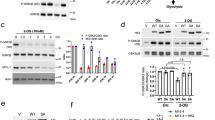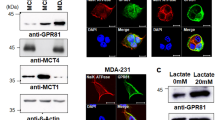Abstract
Phosphoglycerate mutase 1 (PGAM1) is a glycolytic enzyme that coordinates glycolysis and biosynthesis to promote cancer growth via its metabolic activity. Here, we report the discovery of a non-metabolic function of PGAM1 in promoting cancer metastasis. A proteomic study identified α-smooth muscle actin (ACTA2) as a PGAM1-associated protein. PGAM1 modulated actin filaments assembly, cell motility and cancer cell migration via directly interacting with ACTA2, which was independent of its metabolic activity. The enzymatically inactive H186R mutant retained its association with ACTA2, whereas 201–210 amino acids deleted PGAM1 mutant lost the interaction with ACTA2 regardless of intact metabolic activity. Importantly, PGAM1 knockdown decreased metastatic potential of breast cancer cells in vivo and PGAM1 and ACTA2 were jointly associated with the prognosis of breast cancer patients. Together, this study provided the first evidence revealing a non-metabolic function of PGAM1 in promoting cell migration, and gained new insights into the role of PGAM1 in cancer progression.
This is a preview of subscription content, access via your institution
Access options
Subscribe to this journal
Receive 50 print issues and online access
$259.00 per year
only $5.18 per issue
Buy this article
- Purchase on Springer Link
- Instant access to full article PDF
Prices may be subject to local taxes which are calculated during checkout




Similar content being viewed by others
References
Hsu PP, Sabatini DM . Cancer cell metabolism: warburg and beyond. Cell 2008; 134: 703–707.
Kroemer G, Pouyssegur J . Tumor cell metabolism: cancer's Achilles' heel. Cancer Cell 2008; 13: 472–482.
Vander Heiden MG, Cantley LC, Thompson CB . Understanding the Warburg effect: the metabolic requirements of cell proliferation. Science 2009; 324: 1029–1033.
Ward PS, Thompson CB . Metabolic reprogramming: a cancer hallmark even warburg did not anticipate. Cancer Cell 2012; 21: 297–308.
Yang W, Xia Y, Ji H, Zheng Y, Liang J, Huang W et al. Nuclear PKM2 regulates beta-catenin transactivation upon EGFR activation. Nature 2011; 480: 118–122.
Luo W, Hu H, Chang R, Zhong J, Knabel M, O'Meally R et al. Pyruvate kinase M2 is a PHD3-stimulated coactivator for hypoxia-inducible factor 1. Cell 2011; 145: 732–744.
Yang W, Xia Y, Hawke D, Li X, Liang J, Xing D et al. PKM2 phosphorylates histone H3 and promotes gene transcription and tumorigenesis. Cell 2012; 150: 685–696.
Gao X, Wang H, Yang JJ, Liu X, Liu ZR . Pyruvate kinase M2 regulates gene transcription by acting as a protein kinase. Mol Cell 2012; 45: 598–609.
Majewski N, Nogueira V, Bhaskar P, Coy PE, Skeen JE, Gottlob K et al. Hexokinase-mitochondria interaction mediated by Akt is required to inhibit apoptosis in the presence or absence of Bax and Bak. Mol Cell 2004;16: 819–830.
Mathupala SP, Ko YH, Pedersen PL . Hexokinase-2 bound to mitochondria: cancer's stygian link to the 'Warburg Effect' and a pivotal target for effective therapy. Semin Cancer Biol 2009; 19: 17–24.
Fothergill-Gilmore LA, Watson HC . The phosphoglycerate mutases. Adv Enzymol Relat Areas Mol Biol 1989; 62: 227–313.
Durany N, Joseph J, Jimenez OM, Climent F, Fernandez PL, Rivera F et al. Phosphoglycerate mutase, 2,3-bisphosphoglycerate phosphatase, creatine kinase and enolase activity and isoenzymes in breast carcinoma. Br J Cancer 2000; 82: 20–27.
Chen G, Gharib TG, Wang H, Huang CC, Kuick R, Thomas DG et al. Protein profiles associated with survival in lung adenocarcinoma. Proc Natl Acad Sci USA 2003; 100: 13537–13542.
Li C, Xiao Z, Chen Z, Zhang X, Li J, Wu X et al. Proteome analysis of human lung squamous carcinoma. Proteomics 2006; 6: 547–558.
Narayanan NK, Narayanan BA, Nixon DW . Resveratrol-induced cell growth inhibition and apoptosis is associated with modulation of phosphoglycerate mutase B in human prostate cancer cells: two-dimensional sodium dodecyl sulfate-polyacrylamide gel electrophoresis and mass spectrometry evaluation. Cancer Detect Prev 2004; 28: 443–452.
Turhani D, Krapfenbauer K, Thurnher D, Langen H, Fountoulakis M . Identification of differentially expressed, tumor-associated proteins in oral squamous cell carcinoma by proteomic analysis. Electrophoresis 2006; 27: 1417–1423.
Engel M, Mazurek S, Eigenbrodt E, Welter C . Phosphoglycerate mutase-derived polypeptide inhibits glycolytic flux and induces cell growth arrest in tumor cell lines. J Biol Chem 2004; 279: 35803–35812.
Evans MJ, Saghatelian A, Sorensen EJ, Cravatt BF . Target discovery in small-molecule cell-based screens by in situ proteome reactivity profiling. Nat Biotechnol 2005; 23: 1303–1307.
Hitosugi T, Zhou L, Elf S, Fan J, Kang HB, Seo JH et al. Phosphoglycerate mutase 1 coordinates glycolysis and biosynthesis to promote tumor growth. Cancer Cell 2012; 22: 585–600.
Ren F, Wu H, Lei Y, Zhang H, Liu R, Zhao Y et al. Quantitative proteomics identification of phosphoglycerate mutase 1 as a novel therapeutic target in hepatocellular carcinoma. Mol Cancer 2010; 9: 81.
Hitosugi T, Zhou L, Fan J, Elf S, Zhang L, Xie J et al. Tyr26 phosphorylation of PGAM1 provides a metabolic advantage to tumours by stabilizing the active conformation. Nat Commun 2013; 4: 1790.
Hinz B, Gabbiani G, Chaponnier C . The NH2-terminal peptide of alpha-smooth muscle actin inhibits force generation by the myofibroblast in vitro and in vivo. J Cell Biol 2002; 157: 657–663.
Rockey DC, Weymouth N, Shi Z . Smooth muscle alpha actin (Acta2) and myofibroblast function during hepatic wound healing. PloS One 2013; 8: e77166.
Guo DC, Pannu H, Tran-Fadulu V, Papke CL, Yu RK, Avidan N et al. Mutations in smooth muscle alpha-actin (ACTA2) lead to thoracic aortic aneurysms and dissections. Nat Genet 2007; 39: 1488–1493.
Morisaki H, Akutsu K, Ogino H, Kondo N, Yamanaka I, Tsutsumi Y et al. Mutation of ACTA2 gene as an important cause of familial and nonfamilial nonsyndromatic thoracic aortic aneurysm and/or dissection (TAAD). Hum Mutat 2009; 30: 1406–1411.
Lee HW, Seol HJ, Choi YL, Ju HJ, Joo KM, Ko YH et al. Genomic copy number alterations associated with the early brain metastasis of non-small cell lung cancer. Int J Oncol 2012; 41: 2013–2020.
Lee HW, Park YM, Lee SJ, Cho HJ, Kim DH, Lee JI et al. Alpha-smooth muscle actin (ACTA2) is required for metastatic potential of human lung adenocarcinoma. Clin Cancer Res 2013; 19: 5879–5889.
Hu H, Juvekar A, Lyssiotis CA, Lien EC, Albeck JG, Oh D et al. Phosphoinositide 3-kinase regulates glycolysis through mobilization of aldolase from the actin cytoskeleton. Cell 2016; 164: 433–446.
Olson MF, Sahai E . The actin cytoskeleton in cancer cell motility. Clin Exp Metastasis 2009; 26: 273–287.
Croise P, Estay-Ahumada C, Gasman S, Ory S . Rho GTPases, phosphoinositides, and actin: a tripartite framework for efficient vesicular trafficking. Small GTPases 2014; 5: e29469.
Hallows WC, Yu W, Denu JM . Regulation of glycolytic enzyme phosphoglycerate mutase-1 by Sirt1 protein-mediated deacetylation. J Biol Chem 2012; 287: 3850–3858.
Gyorffy B, Lanczky A, Eklund AC, Denkert C, Budczies J, Li QY et al. An online survival analysis tool to rapidly assess the effect of 22,277 genes on breast cancer prognosis using microarray data of 1,809 patients. Breast Cancer Res Treat 2010; 123: 725–731.
Durany N, Joseph J, Cruz-Sanchez FF, Carreras J . Phosphoglycerate mutase, 2, 3-bisphosphoglycerate phosphatase and creatine kinase activity and isoenzymes in human brain tumours. Br J Cancer 1997; 76: 1139–1149.
Yeh CS, Wang JY, Chung FY, Lee SC, Huang MY, Kuo CW et al. Significance of the glycolytic pathway and glycolysis related-genes in tumorigenesis of human colorectal cancers. Oncol Rep 2008; 19: 81–91.
Kondoh H, Lleonart ME, Gil J, Wang J, Degan P, Peters G et al. Glycolytic enzymes can modulate cellular life span. Cancer Res 2005; 65: 177–185.
Fritz G, Kaina B . Rho GTPases: promising cellular targets for novel anticancer drugs. Curr Cancer Drug Targets 2006; 6: 1–14.
Lambrechts A, Van Troys M, Ampe C . The actin cytoskeleton in normal and pathological cell motility. Int J Biochem Cell Biol 2004; 36: 1890–1909.
Thomasson MS, Macnaughtan MA . Microscopy basics and the study of actin-actin-binding protein interactions. Anal Biochem 2013; 443: 156–165.
Acknowledgements
This work was supported by the China International Science and Technology Cooperation Program (No. 2015DFM30040 to MH), the National Science and Technology Major Project (No. 2015ZX09101009 to MH), grants from the National Natural Science Foundation of China (No. 81573464 to MH, No. 81321092 to JD) and NSFC-Shandong Joint Fund for Marine Science Research Centers (No. U1406402 to JD)
Author information
Authors and Affiliations
Corresponding authors
Ethics declarations
Competing interests
The authors declare no conflict of interest.
Additional information
Supplementary Information accompanies this paper on the Oncogene website
Supplementary information
Rights and permissions
About this article
Cite this article
Zhang, D., Jin, N., Sun, W. et al. Phosphoglycerate mutase 1 promotes cancer cell migration independent of its metabolic activity. Oncogene 36, 2900–2909 (2017). https://doi.org/10.1038/onc.2016.446
Received:
Accepted:
Published:
Issue Date:
DOI: https://doi.org/10.1038/onc.2016.446
This article is cited by
-
Exosomal PGAM1 promotes prostate cancer angiogenesis and metastasis by interacting with ACTG1
Cell Death & Disease (2023)
-
Non-metabolic role of alpha-enolase in virus replication
Molecular Biology Reports (2023)
-
Different pancreatic cancer microenvironments convert iPSCs into cancer stem cells exhibiting distinct plasticity with altered gene expression of metabolic pathways
Journal of Experimental & Clinical Cancer Research (2022)
-
Crosstalk between mechanotransduction and metabolism
Nature Reviews Molecular Cell Biology (2021)
-
HKB99, an allosteric inhibitor of phosphoglycerate mutase 1, suppresses invasive pseudopodia formation and upregulates plasminogen activator inhibitor-2 in erlotinib-resistant non-small cell lung cancer cells
Acta Pharmacologica Sinica (2021)



